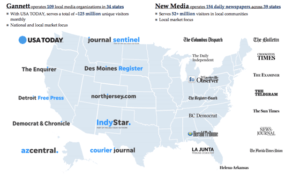The Newspaper Chronicles
Skip to commentsToday Comic Strip of the Day had a take on The Candorville Chronicle.
Which gives me an opening to pass on some newspaper news.
While the main focus in covering the squeeze on newspapers is how it affects reporters and editors (and here there is an emphasis on newspaper comic strips and cartoonist), others within the newspaper industry are also afflicted.
At the end of 2019, McClatchy, the media conglomerate that owns the Miami Herald and El Nuevo Herald, announced it would stop printing Saturday editions of the newspaper and run extended “weekend editions” instead.
As it turns out, beginning April 26, those newspapers will also no longer be printed in Miami-Dade County or by Miami Herald employees. Herald publisher and executive editor Aminda “Mindy” Marqués González last night announced in a companywide memo that the Herald is closing its Doral-based production plant and will instead print six days’ worth of newspapers at the Sun Sentinel‘s press in Deerfield Beach.
Yesterday’s decision also means the Herald will cut a staggering 70 jobs — 34 full-time and 36 part-time printing press and packaging employees. In the meantime, McClatchy CEO Craig Forman receives $35,000 per month as a housing stipend on top of his million-dollar annual salary. He also received a $1 million bonus in 2019, according to Securities and Exchange Commission records.
The Miami New Times carries the story.
The Miami Herald itself also informs:
Closing the plant will mean 70 employees — 34 full time and 36 part time — will lose their jobs, [president, publisher and executive editor] Marqués said…“We are deeply grateful to the entire production team whose steadfast work has built a reputation of dependability and excellence for the Miami Herald and el Nuevo Herald and has served our community loyally,” Marqués said.
and
Several other Florida news organizations have made similar moves with printing operations. The Palm Beach Post moved its printing to the Sun Sentinel in 2009. Last month, the Naples Daily News announced it was moving print operations for Naples and the Fort Myers News-Press to Sarasota, effective in February.
I wonder where The Miami Herald will fall in the Sun Sentinel press schedule. I would assume it will move the deadline forward several hours, making the news even older than usual. I have also found that printing elsewhere frequently screws readers out of the box scores for the night games. Fans of the Heat, the Dolphins, the Marlins, the Panthers, plus college and high school sports will turn elsewhere for up-to-date results instead waiting an extra day for the scores to appear in the paper. And a number will not re-subscribe.
The Herald is a McClatchy paper.
It was in mid-November that McClatchy made the announcement that shook an already shaken industry: It wouldn’t be able to make its expected pension payments. Since then, in cascading fashion, the company has appealed to the federal Pension Benefit Guaranty Corp for “distressed” relief and, just a week ago, simply stopped paying part of its pension obligation.
The above is part of a recent Nieman Lab report on the Tribune newspapers:
In newspapers, the focus is on Tribune Publishing and McClatchy — two of the few remaining national news chains not operated by hedge funds or private equity, each with its own reasons to enter the new year warily.
Monday drove the point home. Thirteen days into the year, Tribune — which only last year had seemed like a relative pillar of industry stability — announced a broad buyout plan, calling it necessary to avoid “company-wide reductions of the workforce.”
That bit of HR news arrived less than two months after industry vulture Alden Global Capital bought up 32 percent of the company. It may not be operating Tribune formally — but Tribune is suddenly acting a lot like an Alden company
The Nieman Lab item concentrates on the Alden possibilities:
…make no mistake that Excels are flying back and forth on the numbers of a Tribune/MNG merger.
How soon might we see one?
That’s always hard to judge. But we know that conditions change markedly on June 30. As I explained last month, that’s the date when restrictions lift on what Alden can do with its 32 percent share of Tribune and what Patrick Soon-Shiong can do with his 25 percent. When that calendar page flips, the dealmaking options expand.
But things, in the short term, are looking up for investors in the New Gannett.
Gannett Co. is a massive newspaper/digital media holding company formed by a massive merger at the end of 2019.
The company pays a huge dividend that yields 11%. Despite the outsized yield, the dividend is actually well funded based on projected 2020 cash flows.
The stock is speculative based on high degrees of risk from needed cost cuts and a rapidly declining newspaper industry [emphasis added]. However, success in reaching management’s goals presents upside.
Seeking Alpha looks at investing in Gannett Co., Inc.
The marriage of New Media Investment Group and Gannett was a merger so large that it had to gain antitrust approval from the Department of Justice. The merger gives Gannett Co. a virtual nationwide footprint through the company’s publishing of USA Today, as well as exposure to 47 states via more than 200 publications. The company is a mix of printed and digital products.
Given how many businesses in the newspaper industry have struggled with the transition from printed ad revenue to monetizing digital models, industry consolidation makes sense. The Gannett-New Media merger simply took consolidation to a massive scale. The newly formed entity will generate roughly $4 billion in annual revenues.





Comments 1
Comments are closed.